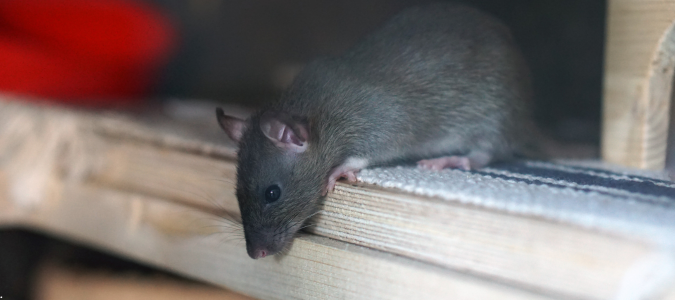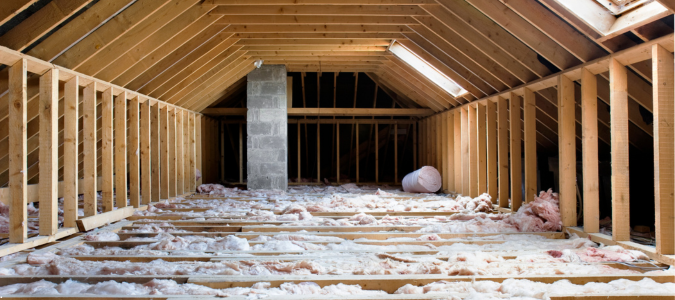You’ve probably heard of roof rats and Norway rats, but do you know what sets them apart? These two species are the most common types of rats in Texas and the southern U.S., so it’s important to learn what you can about them.
While it’s not always easy to tell rat species apart, roof rats and Norway rats have several key differences.
If you suspect that you have a rat problem of any kind, either inside your house or on your property, call in a pest control professional.
Roof Rat Identification: Habitat, Appearance and Behavior
As their name suggests, roof rats, pictured above, are known for their climbing abilities. They often climb trees or powerlines to access your roof. From there, they find a small opening to enter your house and set up camp in your rafters, inside your walls or in your attic.
Roof rats prefer warm environments, which is why they like to nest in locations that are high up. When they aren’t inside, they nest in trees, shrubbery and vines.
Appearance
These pests are slender rats with long tails. In fact, their tails are often longer than their bodies, which measure between six to eight inches long. They have large facial features, including big eyes and ears, and a pointed nose. They have smooth, dark brown or black fur.
Behavior
Since rats are nocturnal creatures, roof rats are most active at night. They eat many different types of food but prefer fruits, grains and nuts.
Norway Rat Identification: Habitat, Appearance and Behavior
Unlike roof rats, Norway rats, pictured above, like to stay close to the ground. They are known for their excellent digging skills and often build nests in underground burrows.
Other common Norway rat nesting sites include near foundations, inside sewers and in wood piles. These pests prefer cooler environments and they can make their way into homes through sewer lines.
Appearance
Besides where you find them, an easy way to tell Norway rats apart from roof rats is by their appearance. Unlike roof rats, Norway rats are stocky and heavy-bodied, and their tails are shorter than their bodies, which measure between seven to nine inches long.
Norway rats have smaller facial features, including small eyes and ears, and a blunt nose. Their coarse fur is either gray or dark brown.
Behavior
These rats do not climb, but they are excellent diggers. What do rats like to eat? Norway rats eat anything they can get their hands on, including meat, garbage and pet food.
If you suspect you have a rat problem, even if you don’t know what species you’re dealing with, it’s time to call in a pest control professional. Rats reproduce rapidly, so it’s important to act quickly when you’re dealing with an infestation.
What Attracts Rats Outside?
Before rats infest homes, they start outside and take up residence on your property. Yards can offer rats exactly what they’re looking for: food, water and shelter.
Outdoor food sources for rats include trash, compost piles, fallen fruit, garden produce, bird feeders and grease drippings from grills. They can access water from leaky hoses or faucets, outdoor pet water bowls, birdbaths, clogged gutters or air conditioning condensation.
For shelter, outdoor rats can hide in overgrown vegetation and debris, wood piles, under decks and porches or inside sheds and garages.
How to Deter Outdoor Rats From Your Yard
Luckily, there are several things that homeowners can do to make their yards less appealing to rats. The best place to start is with your trash. Make sure your outdoor trash bins have secure, tight-fitting lids. Don’t leave garbage bags uncovered outside.
Next, maintain a clean, clutter-free yard. Remove debris and wood piles, clean up waste and fallen fruit and mow your lawn on a regular basis. You should also keep your shrubs and other vegetation trimmed back.
If you have a pet, bring their outdoor food and water bowls inside overnight. Store pet food in upright and sealed containers.
Lastly, seal any entry points that would allow rats to gain access to your home. That includes holes or cracks in your foundation or siding, near doorways and windows and around vents.
If you have a rat problem outdoors, it likely won’t be long until you have a rat problem indoors, too. Stay proactive and work with a pest control professional to take care of the problem before it becomes a major annoyance. An expert can help you put prevention methods in place to help deter rats and block them from entering your home.
Do Roof Rats Come In the House?
If you’ve seen roof rats around your property, it’s normal to wonder if they also come inside the home. The answer is yes, roof rats do come into the house. In fact, they seek out homes because they offer plenty of shelter, warmth, food and water.
Roof rats like to nest in elevated places because it keeps them safe from predators. In homes, they seek out attics and rafters. You may also find them inside wall voids, ceiling insulation and upper cabinets or other storage areas.
How Do Roof Rats Get In?
How do roof rats get inside homes? They use their climbing skills to make their way up tall trees and power lines and access your roof. From there, they look for an opening into the home. Shockingly, roof rats only need an opening the size of a quarter.
Many homeowners wonder if roof rats have bones since they can squeeze through such a small opening. While they do have bones, their bodies are also incredibly limber, making it possible for them to squeeze through tiny spaces.
Your roof can offer several potential entry points for roof rats. For example, they may use gaps in your roofline, your open chimney, unsealed attic vents, holes around cables and pipes and cracks in your siding.
The best way to keep roof rats out of your home is to make it harder for them to access your roof. Keep any trees and shrubs around your home trimmed back, and seal any openings around your roof that are the size of a quarter or larger.
If you suspect that there are roof rats in your home, contact a pest control service. Roof rats are agile pests that are excellent at hiding, so it’s best to leave controlling them to the experts.
Do Norway Rats Go Into Attics?
The biggest difference between roof rats and Norway rats is where they nest. Roof rats like to nest in high places while Norway rats prefer ground level or even underground. However, some homeowners still wonder if Norway rats go into attics.
The short answer is yes, Norway rats can and do go into attics. However, it’s not their first choice for a nesting location. They will try to nest in one of their preferred locations, such as underground or in basements, before going into an attic.
Other Norway rat nesting sites that are more common than attics include under wood piles and compost bins, in burrows along the foundations of buildings, inside wall voids and crawl spaces and beneath sheds or porches.
Unlike roof rats, Norway rats prefer cool temperatures and are not as skilled at climbing. Instead, they are excellent diggers. Lower nesting sites offer both the temperature they prefer and take advantage of their digging skills, while also keeping them safe and providing food and water sources.
While it’s not impossible to spot Norway rats in your attic, it’s not common. No matter where you see Norway rats on your property, you should work with a pest control professional to control them.
Control Indoor and Outdoor Rats With Professional Help
A rat infestation is often a homeowner’s worst nightmare. Luckily, with professional interventions, you can control rat infestations both inside your home and on your property.
An expert pest control specialist can identify the rat species you’re dealing with and locate their nesting grounds. From there, they can control the population and put prevention measures in place to help deter them in the future.
ABC Can Help With Any Pest Problems
It can feel frustrating when rats infest your property. Instead of spending your time trying to get rid of rats on your own, contact ABC Home & Commercial Services. Our experts will be able to control the rodents on your property. We will create a custom pest treatment plan, so you don’t have to worry about these creatures.





